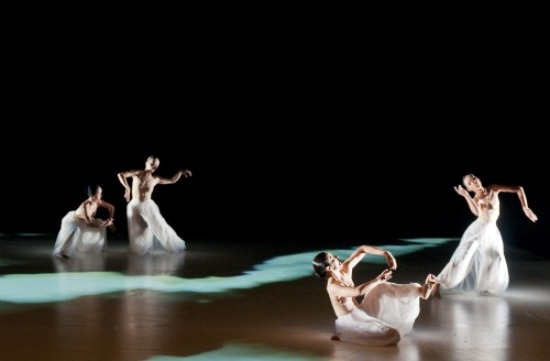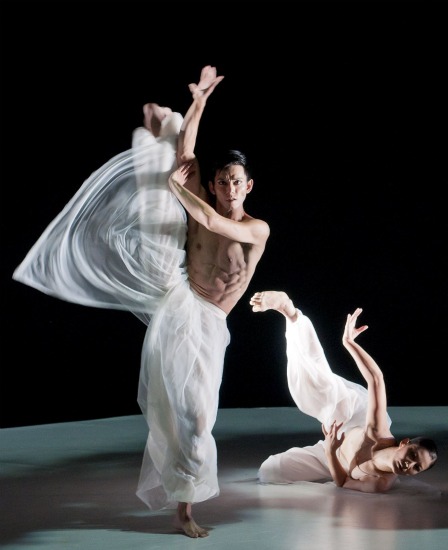Eighteen or so men and women stand motionless, spaced out on a slanting white floor with one truncated corner. All of them wear long, full, white skirts made of a translucent fabric. The men are bare-chested, while the women wear flesh-colored tops. But wait! Are they motionless? As a drawn-out, piercing sound breaks the silence, you’re suddenly aware of shifts in the dancers’ bodies. These shifts are very slight; the stage resembles a field of grass responding to the barest hint of a breeze. Then you realize that the performers are walking very slowly, with tiny, smooth steps, toward the audience.
These performers are members of Taiwan’s Cloud Gate Dance Theatre, and this is Water Stains on the Wall by the company’s artistic director, Lin Hwai-Min. The stage being transformed by his choreography and set design—as well as by Toshio Hosokawa’s music, Lulu W.H. Lee’s lighting, Lin Ching-Ju’s costumes, and Ethan Wang’s projections—is that of the Brooklyn Academy of Music on October 12 through 15.
Water Stains on the Wall is the latest of several dances by Lin Hwai-Min that investigate different styles of calligraphy (his Wild Cursive was shown at BAM in 2007). A legendary conversation between two calligraphers linked the image of water stains with the cloud formations that inspired one of the master’s brushwork.
Lin’s meditative, exquisitely designed piece invites metaphors. The dark, irregular shapes from video projections that periodically swim over the white floor, staining it and the dancers, resemble both scudding clouds and spilling ink. When I imagine a flavor for Water Stains on the Wall, the taste of lychee nuts comes to mind—lychee with perhaps three grains of red pepper.
Over the blank paper of the stage, the dancers create lines and curlicues—both through their quiet processions into the space and out of it and through the flurry of their limbs and the responding billow of their skirts. Su I-Ping introduces the image of writing both near the beginning and at the end of the piece; her arms trace watery patterns on the air around her, the softness of her gestures punctuated by sudden arrests in motion that are reminiscent of martial arts poses. As the dance unfolds, its clarity of design is balanced by movements less obviously precise, as if a master’s brush were gliding freely over a page, powered by the practiced fluidity of his wrist.
In all their comings and goings over the 70-minute piece, the dancers rarely touch, or even stay very close to one another—not even in duets like the tranquil one performed by Huang Mei-Ya and her partner, Lin Chia-Liang. It’s almost shocking when Chou Chang-Ning falls to the ground and Yu Chien-Hung kneels briefly beside her. In the tranquil flow, small details stand out: the way dancers drag a clubbed foot across the floor, or Chou lifts her bent leg high and her toes spread out and separate. Tsai Ming-Yuan’s huge, strangely shaped jumps are as shocking as a suddenly slashed brushstroke.
The dancers are remarkable for their control, their flexibility, their intent focus, and the fullness of their movements. Sinking into a lunge or balancing on one leg become major statements, yet always remain part of a larger design. The music—often sparse and delicate, at moments catastrophic— also pits suddenness against smoothness—the clash of a cymbal, say, or the ringing of a triangle, or plucked strings countering a windy flute.
The pace is essentially slow and sustained, even dreamlike. That quality, punctuated by sudden stops and high-energy bursts of motion, gradually creates an overall rhythm to which you can easily become acclimated. Your attention may wander. Water Stains on the Wall is not a display of dramatically charged dancing (although you may discern dramas bubbling delicately beneath its serene surface). Watching it is like watching a swatch of subtly patterned fabric being unrolled past you or happening upon a tribe of strong, beautiful, peaceful people whose rites you find inscrutable, yet mesmerizing.




Hi, just wanted to mention, I enjoyed this blog post. It was helpful. Keep on posting!